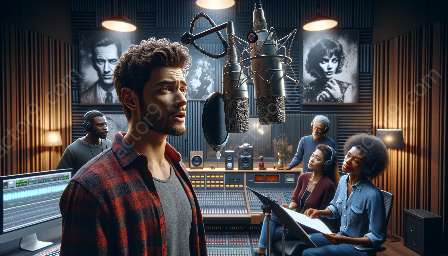The Art of Characterization in Radio Drama
Characterization in radio drama is a complex and multi-faceted art. Through the use of techniques such as voice acting, dialogue, personality traits, and character development, writers and producers can bring their characters to life in the minds of listeners. Effective characterization is the foundation of creating a compelling and memorable radio drama.
Techniques for Establishing Distinct and Memorable Characters
Creating distinct and memorable characters in radio drama involves a combination of strategies that engage the audience's imagination and emotions. The following techniques can help writers and producers in this endeavor:
1. Voice Acting and Performance
Voice acting is a crucial element in radio drama. Skilled actors can use their voices to convey a wide range of emotions, differentiating each character through tone, pitch, pacing, and accents. Engaging voice performances can make characters instantly recognizable and memorable to the audience.
2. Rich and Descriptive Dialogue
Well-crafted dialogue allows characters to reveal their personalities, motivations, and relationships in a natural and captivating manner. By using unique speech patterns, idioms, and verbal quirks, writers can make characters stand out and leave a lasting impression on listeners.
3. Layered Personalities and Traits
Developing multi-dimensional characters with distinct personality traits, strengths, weaknesses, and backstories can add depth and authenticity to the radio drama. By exploring the complexities of each character, writers can create individuals that resonate with the audience and elicit empathy and interest.
4. Symbolism and Imagery
Using symbolic references and visual imagery in the dialogue and narrative can enhance the audience's perception of the characters. Symbolism can convey underlying themes, emotions, and connections, making the characters more memorable and impactful.
5. Effective Sound Design and Music
Strategic use of sound effects and music can contribute to the characterization of individuals and settings in radio drama. By carefully selecting and integrating sound elements that complement the characters' traits and the story's mood, producers can evoke specific moods and associations, heightening the audience's engagement.
6. Character Arcs and Growth
Building character arcs and development throughout the radio drama can allow for dynamic and memorable transformations. By depicting the evolution of characters' beliefs, actions, and relationships, writers can create a compelling journey that resonates with the audience.
Radio Drama Production and Characterization
The production phase plays a crucial role in enhancing the portrayal of characters in radio drama. Through meticulous attention to the following aspects, creators can ensure that characterizations are effectively translated to the audience:
1. Clear Direction and Collaboration
Communication and collaboration between the writer, director, and actors are essential for aligning the vision for character portrayals. Clear direction and understanding of the characters' traits and motivations can lead to cohesive and impactful performances.
2. Soundscaping and Atmosphere
Creating an immersive auditory environment through soundscaping and atmospheric sounds can enrich the portrayal of characters and their surroundings. By incorporating detailed sonic elements, such as ambient noises, the radio drama can transport listeners into the characters' world, enhancing their connection to the story.
3. Balancing Character Focus
In the production process, maintaining a balance in the spotlight on various characters is essential. Careful attention to pacing and timing ensures that each character receives adequate attention and contributes meaningfully to the overall narrative.
4. Quality Post-Production Editing
Thorough post-production editing and mastering are critical for refining the audio quality and ensuring that the nuances of voice performances and sound elements are preserved. High-quality editing enhances the clarity and impact of characterizations in the final presentation.
Conclusion
Creating distinct and memorable characters in radio drama involves a blend of creative writing, performance, and production techniques. By mastering the art of characterization and utilizing effective production methods, creators can captivate their audience through vivid characters, compelling storytelling, and immersive audio experiences.






















